Project 613 (NATO “Whiskey”) conventional attack submarines
 215 submarines (340 initially) 1951-58
215 submarines (340 initially) 1951-58
Soviet Cold War Subs
Pr.613 Whiskey | Pr.611 Zulu | Pr.615 Quebec | Pr.633 Romeo | Pr.651 Juliet | Pr.641 Foxtrot | Pr.641 buki Tango | Pr.877 KiloPr.627 kit November | Pr.659 Echo I | Pr.675 Echo II | Pr.671 Victor I | Pr.671RT Victor II | Pr.671RTMK Victor III | Pr.670/670M skat Charlie | Pr.705 lira Alfa | Pr.949 antey Oscar | Pr.945 Sierra | Pr.971 bars Akula | Pr.885 graney Yasen | Pr. 545 Laika
Pr.629 Golf | Pr.658 Hotel | Pr.667A Yankee | Pr.667B Murena Delta I | Pr.667D Delta II | Pr.667BDR Kalmar Delta III | Pr.667 BDMR delfin Delta IV | Pr. 941 akula Typhoon | Pr.995 borei Dolgorukiy | Pr.09851 Khabarovsk
After seeing the GUPPY, K (Barracuda) and Tang class, first generation conventional (postwar) USN attack submarines, it was logical to see what was their greater concern: The Soviet Navy’s fleet of attack submarines directly based on the German WW2 Type XXI. Known in USSR as Project 613 and in the West assigned the NATO letter W for “Whiskey”, more were made (215) than an other type since the Type VII U-Boats. And they were far more capable. They were modified, producing give patrol variants and four derivatives, notably the first Soviet SSG (conventional missile armed submarines), were exported, and stayed in service until the end of the 1980s. True landmarks of the cold war, here is this story covered in detail. #coldwar #whiskeysub #sovietnavy #sovietsub #submarine #typexxi #sovietskyflot
The mass-built Soviet Submarines
The classic attack submarines of the “Whiskey” class (Project 613) have been after the VIIC U-Boat type the most prolific submarines in history. With 215 units, they have largely exceeded the fleet of “Fleet Snorkels” (Gato class) of the last war. To these were added no less than 21 built by China from Russian parts and equipment. All were registered by an “S” against a “B” for large conventional SMs such as Foxtrot or Zulu, or “K” for nuclear (heavy) and “TK” for Typhoon series (super heavy), or SS for special units.
They were therefore registered from S-80 to S-393 in non-consecutive sequences, built between 1951 (S-80, prototype) and 1958 (the last, S-365), to Gorkiy, Nikolayev, Baltic and Komsomolsk. Whiskey was one of three projects studied in 1946 by the Bureau (TTZ). The 613 projects were medium submersibles, Zulu, big ones. They inherited Project 608 of 1939 and 1943 claiming a unit of 600-700 tons diving at 120 meters, but after the study of the U250 refloated, the project was totally questioned.
In 1947, the TTZ having been rebuilt, the design of the new 613 project began and ended in 1948. The S-80 was put on hold in March 1950. They integrated the study type XXI but still did not the Walter patent. They therefore had a large electric battery and a gun, and two other 25 mm AA.
Development
The first post-war diesel-electric submarine became the massive project 613, a development of the medium displacement project 608 in 1942-1944. At the end of 1944, The Navy received materials on the German Type VIIC U-250 sunk in the Gulf of Finland and then raised which technical characteristics were close to Project 608. In this regard, People’s Commissar Navy Admiral N.G. Kuznetsov decided to stop production of Project 608 until he studied U-250 in detail. Work on Pr. 608 was therefore suspended, then resumed by January 1946, after studying captured submarines of the Type XXI series. Then Commander-in-Chief of the Navy, on recommendation of the State Administration, approved technical specifications (TTZ) for the design of a new diesel submarine, soon assigned Project 613.
Technical characteristics were still partly based on Project 608 but with increasing speed and cruising range, compared to 800t as standard displacement and it was entrusted to TsKB-18 (now TsKB MT Rubin), with appointed chief designer VN Peregudov, then Ya.E. Evgrafov, and from 1950, Z.A. Deribin. Captain 2nd rank L.I. Klimov was the appointed observer for the Navy. In August 1946, an updated TTZ was issued for project 613 and by 08/15/1948 the technical project was approved by the Soviet government. On preliminary sketches, special attention was paid to ensure high performance when submerged position. As a result the submerged speed increased to 13 knots instead of 12. Armament included four bow 533 mm Torpedo Tubes, using the standard WW2 Soviet torpedo models, and two stern ones, same type and caliber. The number of spare torpedoes was increased to 6 (all in the bow).
The main means of detection underwater were the nexly developed GAS “Tamir-5L” and noise direction finding sonar “Phoenix”. Initially, artillery consisted only on AA guns, a twin 57-mm SM-24-ZIF and a paired 25 mm 2M-8, a heavier solution than the two twin 20mm on the Type XXI. Later by 1956 artillery was deleted for good. NATO when discovering the new type called it retroactively the Whiskey I (as basic Project 613 with artillery), see below for the remainder.
Design of the S-80 type
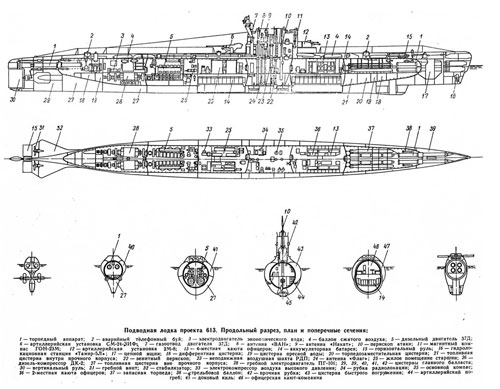
Their hull and equipment were not very different from WWII units, but the specification for a dive over 200 meters, and greater autonomy, as well as mass production, resulted in a submersible more than 1000 tons. Their artillery differed according to the initial versions (Whiskey I, II, III and IV, the latter having a schnorchel). The Whiskey V, on the other hand, had a new, better profiled hull and no artillery pieces (Project 613M). They formed the new production standard in 1955. Their sonars were very much inspired by those of the Type XXI whose engineers were now working (rewarded by a golden bridge) for the USSR.
Hull and general design
By design the Project 613 was a two-hull submarine with a durable pressure and external hulls, both all-welded, with external frames divided into 7 compartments for the pressure hull (hull thickness 25-30 mm), and forming at the battery deck a twin cylindric or “8” shape with the diameter of the lower cylinder being larger than the upper one, and the 1st, 3rd and 7th compartments separated by very strong spherical bulkheads designed for a 10 kg/cm2 pressure to form “shelter compartments” in case of flooding. The remaining bulkheads were designed for a 1 kg/cm2 pressure.
These boats were tought of a “Unsinkable” even if one one compartment and two adjacent ones were flooded.
Ballast consisted in 10 sections located in the external hull and the management of tanks simplified the design and reduced construction cost. The pressurized air was located into 22 cylinders with a volume of about 900 liters, designed for a pressure 200 kg/cm2. The air supply was replenished by 2 diesel compressors.
Initially, these air pipings were made in steel, with an internal coating of copper, but they appeared severely corroded on tests and were replaced with red copper. The main drainage pump was of the type 6МВх2 (capacity 180 m<З/hour at a pressure of 20 m of water column, 22 MW/hour at a pressure of 125 m. There were also bilge-piston pumps TP-20/250 (20 mЗ/hour at 250 m water column). For the first time there was a horizontal stabilize at the aft end of the ship.
Powerplant
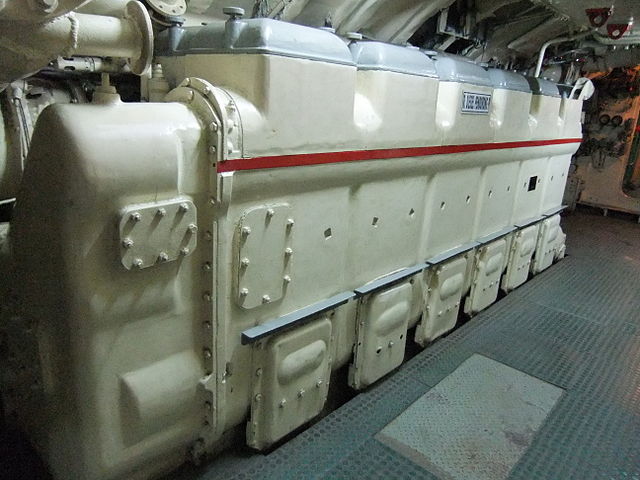
The main powerplant rested on a pair of two-stroke 37D diesel engines, as powerful as the former 1D diesels of pre-war submarines such as the IX-bis and XIII series, but lighter, having less cylinders and smaller dimensions. Two main electric motors PG-101 1350 hp added their own power to provide the requested full speed, and a pair of “silent runnung” 50-horsepower PG-103 electric motors. However, the two-stroke 37D diesels were quite noisy, even so shaft Line were installed on soundproof shock absorbers. Shaft rotation was transmitted tp the propellers through elastic and silent textrope transmissions with a gear ratio of 1:3 and tailored friction clutches.
Pneumatic release couplings were located between the diesel engines and hydraulic motors as well and between the motor drive and thrust shafts rigid flanges were installed. These new an innovative types of couplings were for the first time installed on Soviet submarines and made it possible to better soundproof diesel engines and lines shaft.
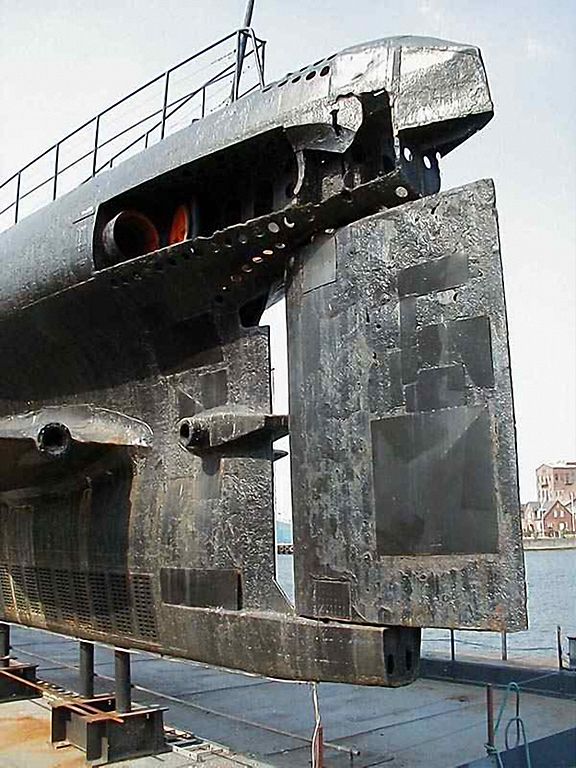
To ensure diesel surface operation at periscope depth a special snorkel was installed which was a retractable shaft to supply fresh air inside and supply the main engines. The air channel was supplied with a float valve to prevent water from entering, basically the German type snorkel with minor improvements. But the base working out the same, with an upper part venting out exhaust gases through a stationary shaft located in the aft part of the CT. A prototype snorkel was already designed by submarine officer Gudim at the start of the century, installed and tested. But there was no use for it at the time, and ot took a few decades so see the device adopted again. Not only the snorkel, Periscopes, exhaust shaft, vertical and horizontal rudders, and ballast valves were all hydraulically driven.
Even for diving and venting out air, a silent system was provided for the first time also, trimming via gas outlets exhausting into the water were directed aft using suction effect of the outboard flow of sawater, reducing noise a bit. An air conditioning unit was also supposed to be installed but it was unsatisfactory and deleted from equipment for mass production.
Each Whiskey class boat uses 10 main ballast tanks into the outer hull with release valves only in tanks No. 4 and No. 5.
Economic surface speed was 8-10 knots and fuel supply enabled 8,580 miles at 10 knots, or 13,000 miles at 8 knots.
On the PG-101 main electric motors alone, top speed underwater was 13.1 knots, maintained for an hour. Economic propulsion used the 50hp PG-103 for a silent approach at 1.97 knots. Using these alone, the battery charge was enough for no less than 352 miles of underwater travel. Diesel capacity was 120,000 litres enabling a maximal theoretical range of 12-15,000 nautical miles at very low speed. Max diving depth was kept secret but said to be around 500 feet.
Battery Power supply comprised two groups of 46SU batteries with 112 cells each in the second and fourth compartments. Charged by the main electric motors, driven in turn by the diesel engines and operated as electricity generators. Thanks to the snorkel, they could be indefinitely reloaded while persicopic depth immersed.
The retractable underwater diesel operating device (RDD) provided this with well separated air intake and exhausts.
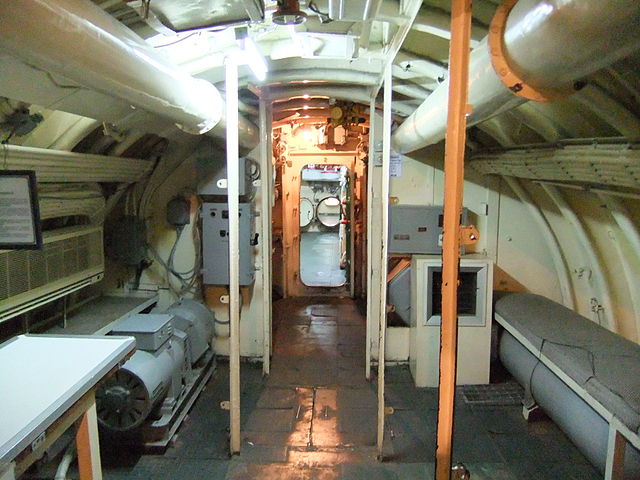
Project 613 used the same two-hull streamlined design as the German Type XXI, all-welded with internal frames division by cast, very strong waterproof bulkheads, creating 7 compartments:
-Fwd Torpedo and (Shelter compartment).
-Battery and residential compartment
-Central post and (Shelter compartment).
-Second group of batteries and living quarters of the foremen.
-Main Diesel room
-Electric motor room
-Aft Torpedo room (Shelter compartment).
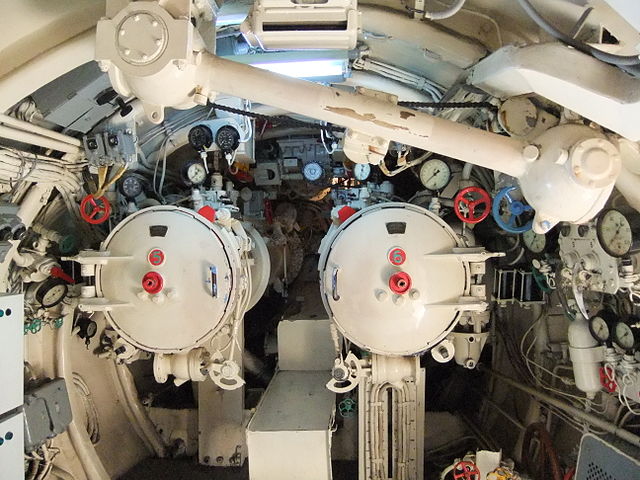
Aft TT compartment
The first, third and seventh compartments were separated by concave bulkheads capable of endurinf pressure down to 90 m while the remaining ones were flat and could only withstand 1 atmosphere. On the deck at the area of the first and seventh compartments were placed emergency buoys, which are automatically released in case of flooding, showing its location and maintaining contact from the surface with submariners trapped inside in one of the three shelter compartments, via telephone communication via a cable connecting the buoy to the boat.
The battery compartments, second and fourth, had a cross-section in “8” with lower part being larger diameter housed the batteries, as on the Type XXI.
Early noted Issues
Powerplant:
Increased temperature bearings and couplings on shaft lines, vibrations, failing tire-pneumatic couplings and replacement issues.
In 1954, when testing of of the early serial submarines, their short-term operation diesel engines continued even after closing the flaps, and this formed in the gas outlet an explosive mixture in which the very first sparks from the diesel engine into the receiver could cause explosion. To remedy this, blocking devices were installed.
Radio: The new emitter/receiver “Nakat” station was not ready and installed in time of the boats’s delivery. It was installed during operation.
Removal of guns
In 1956, by decision of the Council of Ministers, artillery was removed from all boats, after which speed and cruising range increased slightly, notably underwater. During scheduled repairs, the ships had some of their radio-technical equipments replaced. The initial prospects to build 340 of these, after all these problems, was curtailed to 215. It was still a world record, though. They accounted for 50% of Soviet submarines still in the 1970s. In the process of production some changes were made, in particular location and later removal of artillery. The first ten submarines had new hatches installed. These were of the Lebedev type with larger lid opening and larger traction force but still smaller than conventionally designed ones. Even with slight deformation, jamming occurred, thowever, and thus, they were later replaced by Conventional ones.
Armament
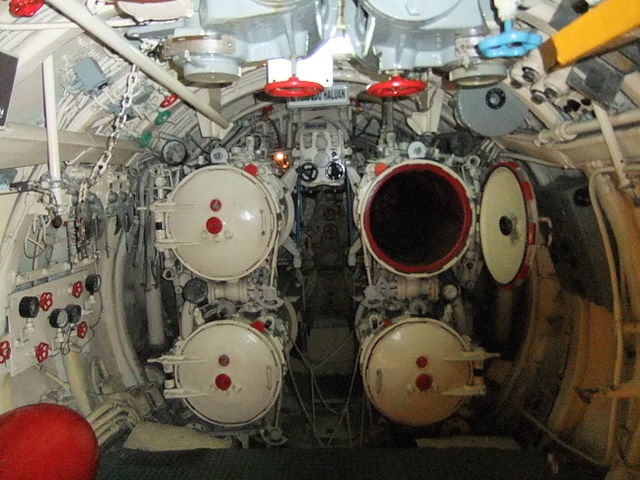
Forward torpedo compartment
This topic is a complicated one. There was an artillery and a torpedo component. Artillery at first included a rear CT twin 57 mm (2.2 in) AA gundeck gun, and a twin tandem 25 mm (1.0 in) AA gun in the conning tower’s forward section under mask. The torpedo tubes were four in the bow, two in the stern, all same caliber, but the torpedo fired were modernizeds over the years.
57 mm
The 57 mm/78.7 (2.24″) SM-24-ZIF was developed specifically in 1947 as a submarine weapon. The prototype of the SM-24 was tested in 1950, showing defects in the mounting and after a redesign z second test campaing in 1951-1953 and last fixes had it accepted by 1955. They still had many operational problems due to the fact they were in open mounts, a liability in the Arctic Ocean. 3-rds Clip fed, 50 rounds before watercooling the barrels for 1-1.5 minutes was necessary (ideally 100-150 rounds per minute). Common cradle. Max Range 9,210 yards (8,420 m), and using the MZP-57-2A-1 optical gun sight practical range was 5,580 yards (5,100 m). Retired by decision after 1955 on all boats. More on navweaps
25 mm
A standard issue an many ships of the Soviet Navy, the 25 mm/79 (1″) 110-PM gun showed a classic “tandem” configuration, being present on the conning tower inside its shield. Designed in 1943-44. reborn in 1945, modified in 1947, Trials 1949, in service by 1953 as 110-PM, production went on until 1983. Small caliber despite the fact it was shown in 1945 already the 20 mm Oerlikon was inefficient against modern planes. 450 rounds per minute, 270 effective, firing a 0.62 lbs. (0.281 kg) (full 1.42 – 1.48 lbs. or 0.644 – 0.672 kg) round at 2,950 fps (900 mps), 5,500 feet (1,700 m) ceiling.
Also retired later from all boats by decision. More on navweaps
Torpedo Tubes
533 mm (21″) ET-46: The “E” means “elektricheskaia torpeda”. Stock model, non homing, based on WW2 experience, in service by 1946. It weight 3,990 lbs. (1,810 kg) for 293 in (7.450 m) long, carrying a 992 lbs. (450 kg) warhead to 6,600 yards (6,000 m) at 31 knots thanks to its Lead-acid battery electric engine. Large stocks still existed.
533 mm (21″) SAET-50 and SAET-50M: Made for the Project 613 submarines. SAET stands for “samonavodiashaiasia akusticheskaia elektricheskaia torpeda”: They were the first Soviet submarine homing acoustic electric-powered torpedoes (1950). Range of the active homing system was however only 600-800m as reported. The SAET-50M (1955) had a more powerful battery for lowering screw propellers noise, this went like a glove with other Whiskey’s stealthy features. Weight 3,638 lbs. (1,650 kg), 293 in (7.450 m) long, warhead 827 lbs. (375 kg). Lead-acid battery, range 4,400 yards/23 knots or 6,600 yards/29 knots for the M.
I will not dwelve into all these types, but the Project 613 also probably operated or were capable of operating the following during their career:
533 mm (21″) 53-51 non-homing kerosene powered fast torpedo (1951)
533 mm (21″) ET-56 electric torpedo (1956)
533 mm (21″) 53-56/V/VA electric torpedo (1955/64/66)
533 mm (21″) 53-57 kerosen/peroxyde fast torpedo (1957)
533 mm (21″) 53-58 Non-homing torpedo nuclear-warhead torpedo (1968)
533 mm (21″) SET-53/SET-53M passive acoustic electric torpedo (1958/1964)
533 mm (21″) 53-61/M “Alligator” Acoustic wake following homing torpedo (1961/69)
533 mm (21″) SAET-60/M Passive acoustical homing “slow” torpedo (Silver-zinc battery) (1961/1969)
533 mm (21″) 53-65/K/M Acoustic wake following homing torpedo (1965/69)
533 mm (21″) SET-65 “Yenot-2″ Guided Electrical Torpedo with active acoustic guidance (1965)
533 mm (21″) TEST-68 wire guided torpedo (1969)
533 mm (21”) TEST-71/MKE/3 improved wire guided torpedoes (1971/77), probably only tested as the Project 613 was now considered obsolete.
Sensors
Project 608, the predecessor of Project 613 already tested a copy of a British sonar system which was reverse engineered, and later improved to be installed on the Pr. 613 boats.
Their complete suite comprised the following:
-Radar complex RLK-101 «Albatros» (from 1958)
-Surface radar «Flag»
-Reconnaissance radar «Anker» (then «Nakat»), «Fakel-MO-1» IFF (then «Khrom-K»), RPN-47-03 (then ARP-53)
-Sonar «Tamir-5L» (then «Plutoniy»)
-Sonar MG-200 «Arktika» (from 1954 on S-154)
-Special sonar MG-15 «Sviyaga» (from 1957)
-Noise detection sonar «Mars» (then MG-10 «Kola», then «Fenix»)
-Underwater communication system «Yakhta» (from 1959 on S-345, 378)
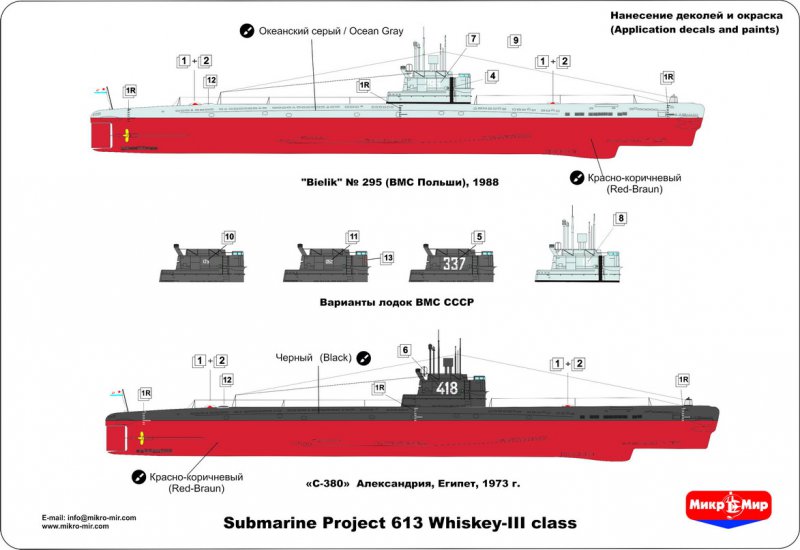
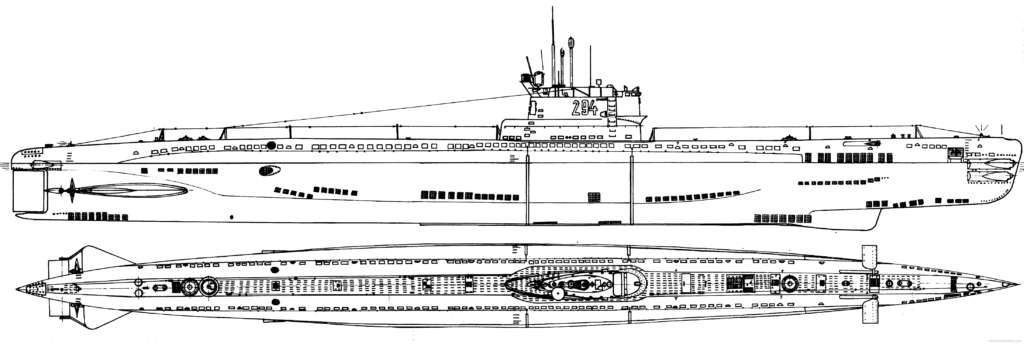
⚙ specifications |
|
| Displacement | 1,050-1,350 tons Surfaced/Underwater |
| Dimensions | 76 x 6.3 x 4.55 m (249 ft 4 in x 21 ft 4 in x 14 ft 11 in) |
| Propulsion | 2 shafts diesel, 4 electrical generators, 6,800 hp. |
| Speed | 18,25/13 knots, 166h submerged |
| Max depth | 200m+ (650 ft) |
| Range | Surfaced: 8,580 nmi (15,890 km)/10 knots, submerged 335 nmi (620 km)/3 knots |
| Armament | 6 21-in TTs (4 bow, 2 stern (12)), 1×2 57 mm, 1×2 25 mm AA, see notes. |
| Sensors | Feniks, Tamir, Sonars Nakat and Flag Radar sensors |
| Crew | 52 |
Modifications
Realized Projects
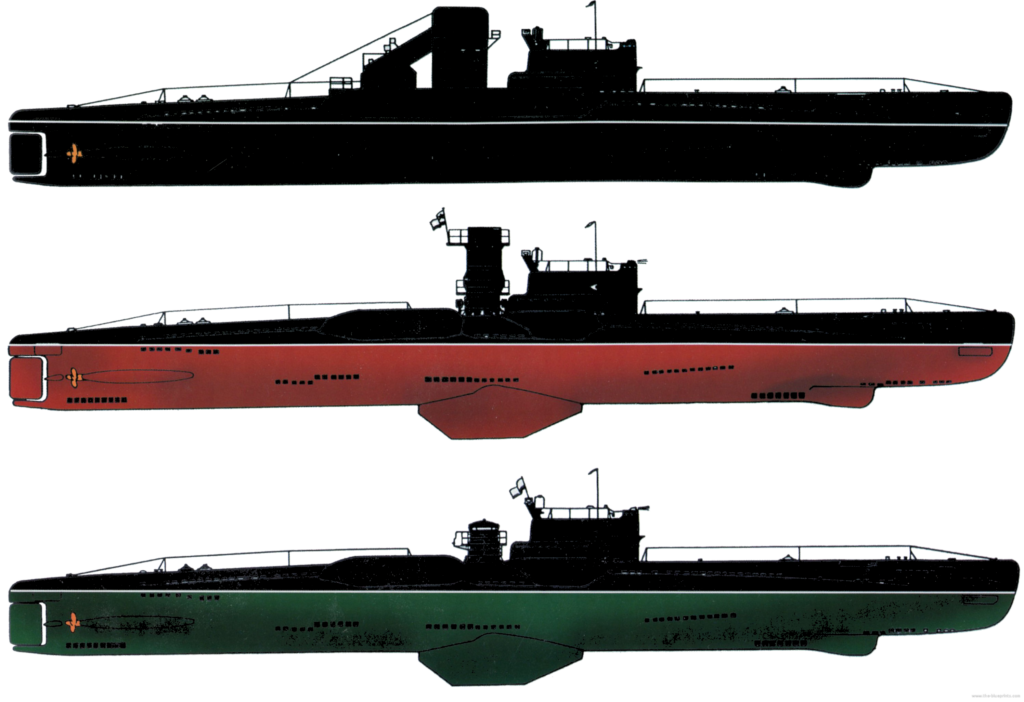
The basic Pr. 613 was often modernized or redesigned, and the next batch of 27 had increased autonomy, ported to 45 days.
Pr. 613B S-384 tested various types of batteries as the 613M and 613Ц as well as ability to fire torpedoes down to 70 m.
Four ships were equipped with long-range radar surveillance stations still listed as regult Project 640 but one of them was retrofitted as Pr. 640Ц whereas Pr. 640U< and 640T modifications were developed but not adopted. These were used to conduct full-scale tests of various types of weapons, even missiles.
Project 613P: S-146 was converted as project 613P for testing cruise missiles of the P-5 type (NATO SS-N-3 Shaddock). After tests were completed, it was into service and six more conenverted.
Project 644: Six submarines were re-equipped as Project 644, two further modernized as projects 644Д and 644.7, and project 644У developed, but stayed on paper stage. They received two 2 cruise missiles each with canisters buried in a molded hull section behind the CT.
Project 665: Six more submarines were converted according to project 665, a further development of 644P and 644PU developed at TsKB-112 with the same P-5 complex but now 4 missiles placed alongside the CT.
Project 613D4: S-229 was converted to project 613D4, test boat for conducting tests of underwater launch for the R-21 ballistic missiles.
Project 613D5 tested on its side the R-27 complex, and project 613D7 the D-7 complex on S-65, re-equiped and rebuilt as project 613РВ to test missile torpedoes.
project 613E: More than 30 submarines were modernized according to other projects, starting with S-273, lead boat of project 613E which tested for the first time an air-independent powerplant (AIP) with ECG and S-43 re-equipped to test new types of rescue equipments, notably a rescue chamber as part of Project 613С. С-63 was converted into a rescue submarine, unique Project 666 boat.
Project 613Х: In 1959, S-345 and S-378 were fitted with a new sound-underwater communication station, project 613Х.
Project 613A/AD: S-72 was modernized as test boat of project 613A and then 613AD, testing new types of missiles such as the “Amethyst” and S-45 was used for destruction tests. Project 613E was equipped with a new airborne detection system.
Project 613Ш was used to test a new under-ice hydroacoustic system and long stays underwater.
Project V-613 tested the R-11FM ballistic missile (R-11 Zemlya or 8A61, NATO SS-1b Scud-A).
Project 3P-613 tested the Zaliv P radar.
Project 613 “August” tested a new rubber coating type “NPPRK-1”.
Project 61311 was an hydroacoustic research boat serie, S-76, S-233, S-186 and S-89 were used to test new anti-submarine systems, the first two as target boats, sheathed with three layers of wood (larch, oak, and propellers protected by a ring. They later were modified as the subclass PL PLO with the UPAK system, guided anti-submarine aerial complex.
Paper projects

Project 613B was a submarine tanker (developed by TsKB-112, later TsKB Lazurit) but used for refueling Beriev BE-10 seaplanes
Project EP-613 was a pre-design development Project 613
Project 613L was to test a device for thawing ice
Project 613U was to be testing a new system for at sea, on the move resplenishment (RAS)
Project 613P-120 was to test launch the Malakhit cruise missiles (NATO ).
“unused” project names were Pr. 613M (artillery system iya), Project 613I and export version, Project 613Х a test boat for a 15-kt rocket in single silo.
Civilian Use and Preservation
Some were converted into training stations and floating charging stations also.
Two were transferred to the Ministry of Fisheries and converted for oceanographic and fishing research boat called Severyanka and the other Slavyanka.
Several were converted into museum boats in Russia, or sold and converted aboard into museums: Sweden renamed its own “U-194” and Denmark “U-359” and “U-137”, former S-174. In Indonesia “Pasopati”also became a well preserved museum ship. In Russia, S-79 is now exhibited in St. Petersburg as S-189 installed as memorial. A museum boat was planned in Prague with a former Albanian boat, but its appealing state had the project cancelled.
Career
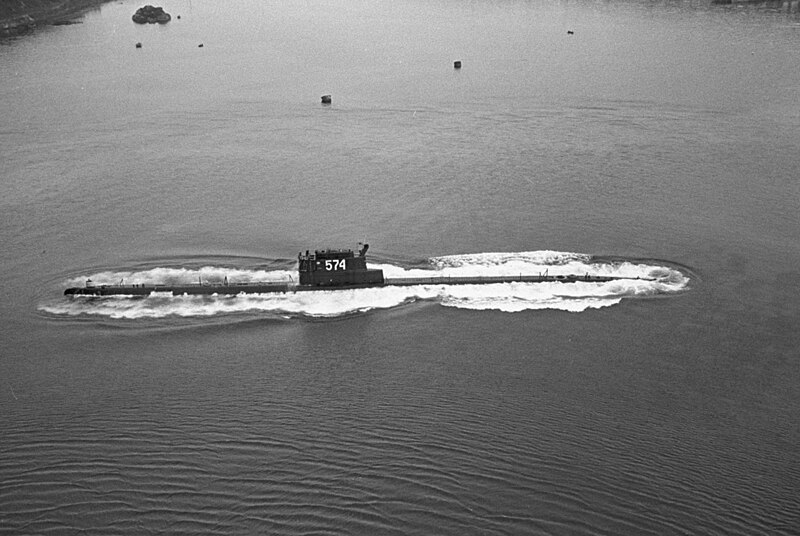
S575 in July 1965
The Whiskey formed the spearhead of the Soviet navy during the first part of the Cold War, like the Guppy conversions for the USN, and the conventional type flourished afterwards in US doctrine. Many believed nuclear power was impractical for submarines, even after the reveal of USS Nautilus, it was still believed by some this was a bluff. Alongside the 1st generation of soviet SSNs (November class), cnventional ones continued to be a constant asset in the inventory: The Quebec, Zulu, Tango and then Foxtrot, which were spiritual successors to the Whiskey, and then the Kilos in the late 1970s. There were many exports already in the late 1950s: Albania: 4, Bulgaria: 2, China: 5 (much more assembled), Cuba: 1, Egypt: 7, Indonesia: 14, North Korea: 4, Poland: 4, Syria: 1. There were also accidents, such as the S-178, sinking after a fatal collision with a 1981 in front of Vladivostok, and the S-137, famous “Whiskey on the Rocks” as derided by the Western press, grounded after a navigation error, trying to spy on the Swedish Naval Base of Karlskrona in 1981. By the 1980s standards, quietness was not the strongest point of this 1950 design to say the least, at least compared to modern SSNs such as the US Los Angeles class.

Submarine monument in Surabaya. Interior:
But overall, they were considered very successful and relatively reliable and sturdy. On two were lost: S-178 in October 1981 (Pacific fleet) in the Eastern Bosphorus Strait and S-80 (Project 644) in January 1961 in the Barents Sea.
There were still 60 in service in 1985, of which 50 were now active. In 1990, there were 18 left in reserve. On the other hand, there were many conversions and modifications, experimental test variants. This was the case of the series of 26 units of the 613V project, the range of action increased by “Jumboization”, 4 of the pole-and-shoot version (NATO “Canvas Bag”), 6 anti-ship missile launchers with 2 ramps SS-N-3 (NATO “Twin cylinder”), 6 with 4 SS-N-3 ramps on the side of the kiosk (NATO “Long Bin”), and 13 other prototypes. One of these “Whiskey” is currently visiting the USA. In addition, the S-194 is for sale in Sweden for 250 000 € and another in the USA for 450 000 $.
Variants
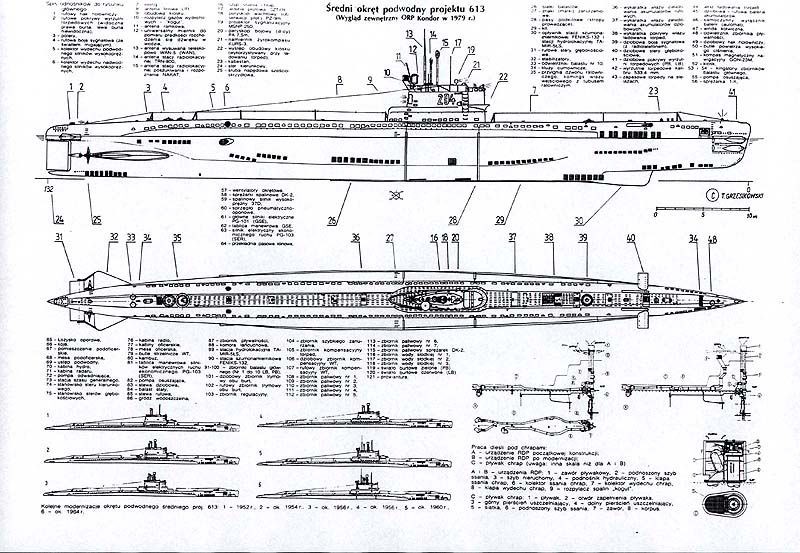
Basic variants
 Whiskey I
Whiskey I

S31 of the Whiskey I class submarines, upgraded to Whiskey II standard later in her career. The red and green hulls depended on their assignation. Green was generally for black sea ships.
Note: Like all following posters, these profiles are a 3D conversions of the originals made by Mike1979 Russia. They are redistribuable under the same CC licence.
Original configuration, with a twin 25 mm (1.0 in) guns forward of the conning tower. Probably only kept for initial batches boats as tested. The sail (conning tower) was located forward of amidships, and it did not change, except the early units had it stepped fore and aft; They had near vertical leading edge, stepped down trailing edge. Fixed snorkel exhaust angles upward on the upper tier of it. Rounded bow, sloped hull gradually from bow to stern and retractable bow planes high on the weatherdeck. Apart the sail, this configuration never changed.
 Whiskey II
Whiskey II
Second configuration Twin 57 mm (2.2 in) guns and twin 25 mm guns, the “full monty”. Seemingly the standard configuration as completed for all boats until 1955. The conning tower shape stayed the same, as the configuration of mast and periscopes, and sonar.
 Whiskey III
Whiskey III

No guns configuration, but improved conning tower. Same ww2 style livery also as before, medium grey and red. Probably all boats post 1955 were delivered that way.
 Whiskey IV
Whiskey IV
A return to the 25 mm guns but some improvements in the conning tower.
 Whiskey V
Whiskey V
S178 of Whiskey III class, lost in the Pacific, 1981
The Whiskey V had No guns and a streamlined conning tower and snorkel for greater speeds. 1957-58 production boats.
Specialized variants
 Project 644 (Whiskey Single Cylinder) 1956
Project 644 (Whiskey Single Cylinder) 1956
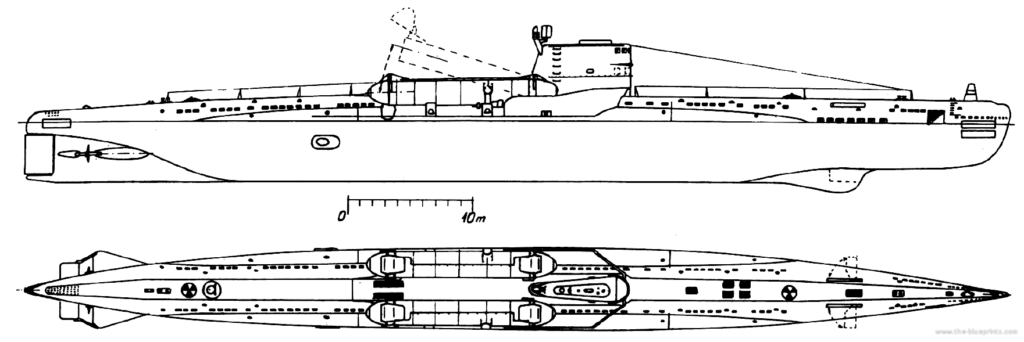
Note: No blueprint found of the “single cylinder” prototype, here is a scheme of the twin cylinder.
First prototype of SSG to fire the SS-N-3 Shaddock cruise missile. Regular boat modified with a launch tube aft of the sail, single SS-N-3c. The NATO “Whiskey Single Cylinder” only served for tests. It helped creating a small serie of SSG next which was operational however.
 Project 644 (Whiskey Twin Cylinder)
Project 644 (Whiskey Twin Cylinder)

Whiskey “twin Cylinder”
1958-1960 saw six additional submarines converted to carry two guided missiles in tubes aslo behind the sail, thus they were dubbed “Whiskey Twin Cylinder”. Officially Project 644. It seems they were operational as part of one of the first SSG squadrons of the Soviet Navy. At the same time they validated the concept, many classes were planned: The Juliett (conventiona) and Echo (nuclear). SSGs (cruise missiles dedicated attack submarines) were unique to the Soviet Navy and the west soon tried to have torpedo-launched missiles and later tube-launch missiles in regular SSNs. It’s now a common feature on all submarine, giving them a “long arm” and more versatility.

For memory the SS-N-3 “Shaddock” was an early missile capable of Mach 0.9 at 450 km (a/b) to 750 km (model C) using inertial guidance and data link updates, then terminal active radar homing and able to carry either a 1000 kg conventional or 200-350 kt nuclear. It was designed as the “carrier-killer” missiles and for long the doctrine was to send a saturation fire with these on a US task force. Displacement: 1,400t FL, beam 23ft or 7m instead of 19 ft (5.8m), all six TTs were kept.
 Project 665 (Whiskey Long Bin)
Project 665 (Whiskey Long Bin)

Whiskey “Long Bin” class SSG
Another type of SSG, were six extra conversion between 1960 and 1963, this time with an extended sail so to accept twoce as much missiles, four of the same type. The “Whiskey Long Bin” (Project 665) carried the P-5 (Shaddock) land-attack missile. However like the previous class, they had to surface to fire their missiles and then raise their missile tubes. The whole operation took some time and made them vulnerable. They were not good seaboats because the launch tubes caused stability problems while water flow around the missile fittings made them very noisy and easily detectable. They did not fare long into service, especially compared to the streamined Juliett class SSG.
Displacement: 1,500t, 275.6 or 84m in lenght, 21.3 ft or 6.5m in beam, 4 bow TTs 21 in (53.3 cm)
 Project 640 (Whiskey Canvas Bag)
Project 640 (Whiskey Canvas Bag)
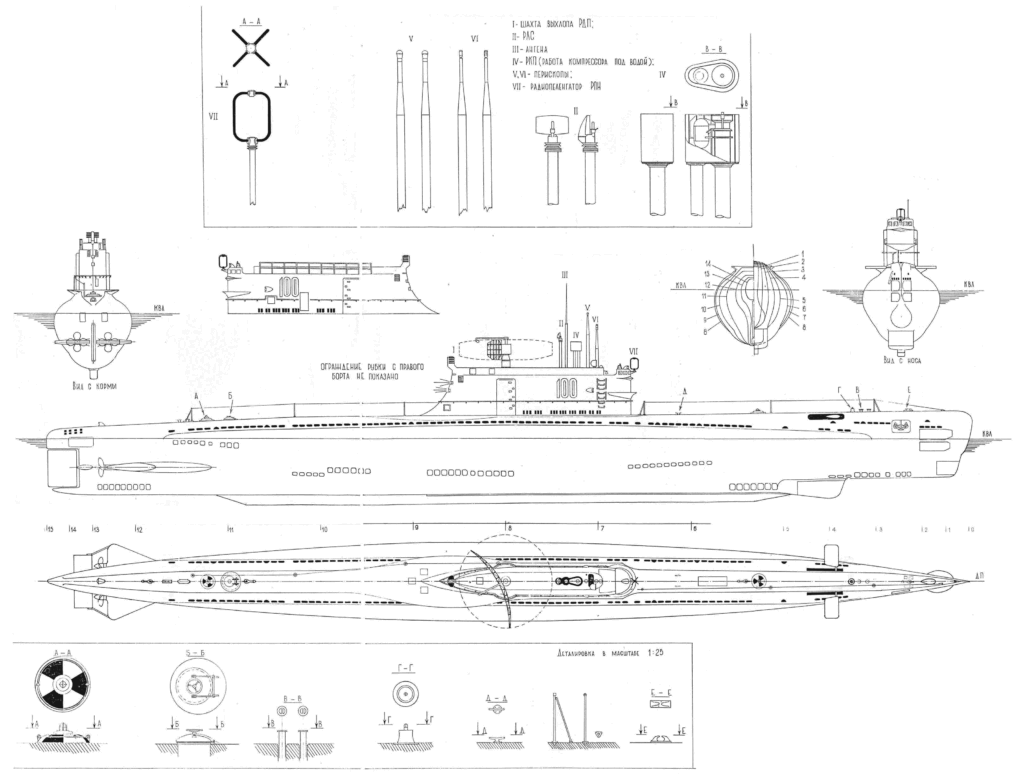
After the withdrawal of the “Long bin”, four were converted to Project 640, the first Soviet dedicated radar picket boats (NATO Canvas Bag). They had a permanently affixed radar antenna, atop the sail. It can be rotated and folded but not retracte and needed for this to the sail aft section to be removed and the projecting fixed snorkel exhaust moved further aft.
Officially deployed as “fishery research” and “oceanographic research” boats, they were intended for spying on relevant NATO harbors. Service was short as they were replaced by Romeo class boats.
Dimensions were the same as the original boats but they only had ther four forward TTs left.
Tactical Organization, records and fate
A change in doctrine
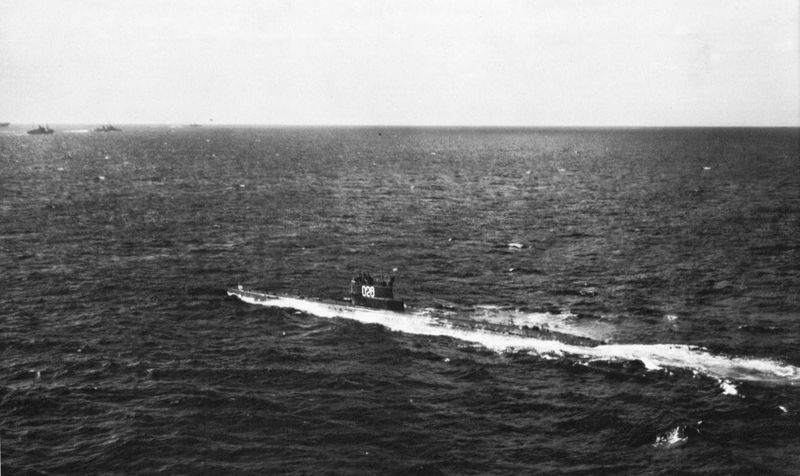
S026 in the Pacific, 1964
Initially the Project 613 boats were just to replace the Type-S ‘Stalinets’ and Type-Shch ‘Shchuka’ class medium range patrol submarines. When Type XXI were received, it evolved, and with a bounty of 215 submarines (236 with the ones built for China) made between 1951 and 1958, and a production peak in 1955, Project 613 boats became the prime frontline submarines deployed in mid-1950s (basically after Stalin’s death). They gradually replaced all the fleet of WW2 submarines still active in the meantime, and were a considerable improvements, but perhaps in livability, although for officers: The mess had a table with 40 seats. The total production number was confirmed by Vice Admiral Burov, head of the Soviet Defense Ministry’s Shipbuilding Institute from 1969 to 1983.
This large number was not about to flood the Atlantic overnight however though. First off, they had to be split between four fleets: Baltic, Northern, Black Sea and Pacific. Second, there was one sub in maintenance/refit when two were in patrol at all times. Third, they were deployed in various tasks and not all had “free range”. Thos eof the Northern Fleet had the particular task of escorting strategic nuclear submarines when they appeared in the 1960s and thus were “tied down” to them. And all the remainder were not assigned to “trade war” but rather dedicated to hunt down USN task forces and their precious carriers, at least until better models arrived, notably SSNs like the November class.
NATO estimated however that since the bulk of these were based on the Baltic, they were all likely to be sent out to the strategic GIUK gap, only passageway to the middle Atlantic and NATO lines of communication. In that configuration, perhaps 50 at best could operating in wolfpacks at all times, so 1/4 roughly of the total available.
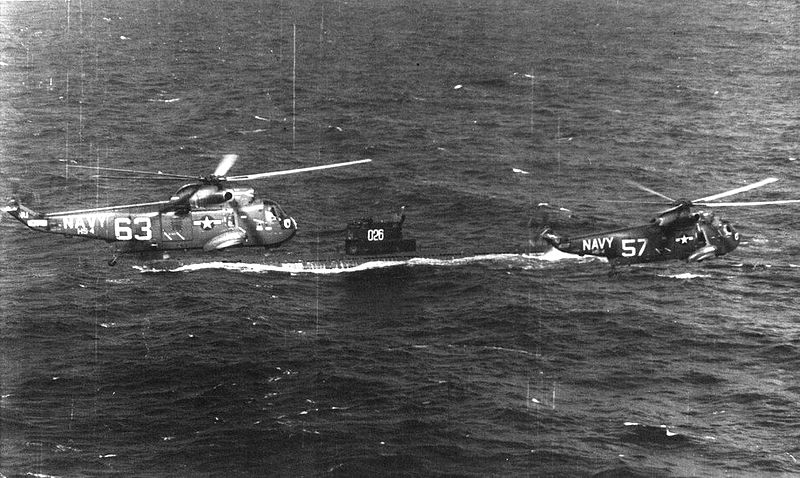
S026 flew over by an SH-3A sea king from HS-4 in the Pacific, 1964, and the US frigate close behind
US intelligence initially foresaw in 1946 a force of no less than 300 Soviet Type XXI equivalents by 1950, somethig even below the 340 initially planned. But it was not until 1949 than the Whiskey and Zulu emerged, Zulu being a “true Type XXI” whereas the Whiskey were a cheaper, simpler alternative. They were more able to do coastal defense and roam closed seas like the Baltic and Black/sea/mediterranean. It was not until the mid-1950s that Whiskeys were even given snorkels.
Tactically, these subs were deployed according to a shore targeting station vectoring, in a planned defense of Soviet sea approaches. The larger Zulu-class and Quebec-class complemented Whiskey-class capabilities by closing some gaps in the defence depending on their own capability. However only 32 Zulu-class submarines ever were built. Given their range, they were coordinated by shore-based aircraft while the c30 small Quebec-class only operating in coastal waters for defensive roles.
US Reaction
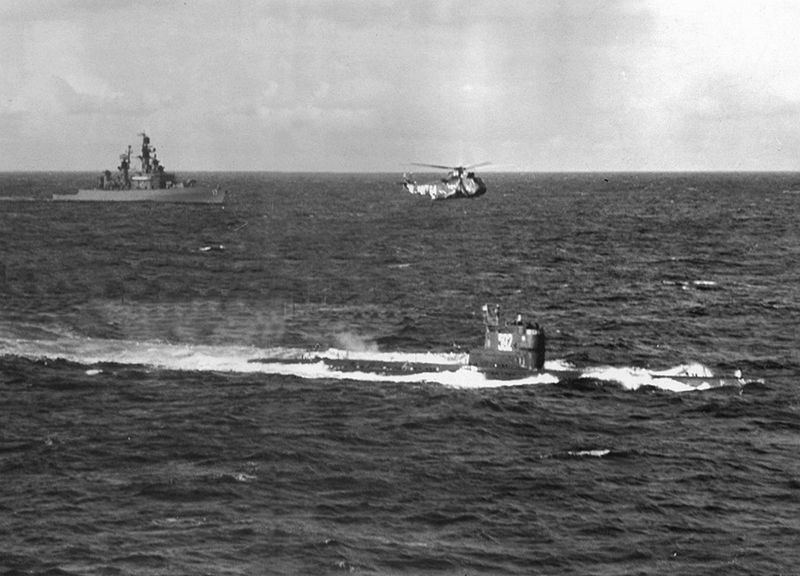
USS Harry EYarnell (DLG-17) and its SH-3A Sea King escort S592 c1967
Still, given their overall performances and initial estimations, and until exact numbers were known, the US naval staff needed many escorts fast (for a 1-2 ratio, two escorts for one sub) that amonunted to 600 escort ship, in a budget-stripped context. This is why many Fletchers were converted as DDE, and the more recent Sumner/Gearing later as FRAM I/II. The first postwar frigates were also built, in larger numbers until the introduction of the mass-produced 1960s Knox class. The idea of small, mass-produced coastal sub-hunters was not reproduced however. ASW warfare culminated until the very large Spruance class destroyers of the 1970s.
Incidents
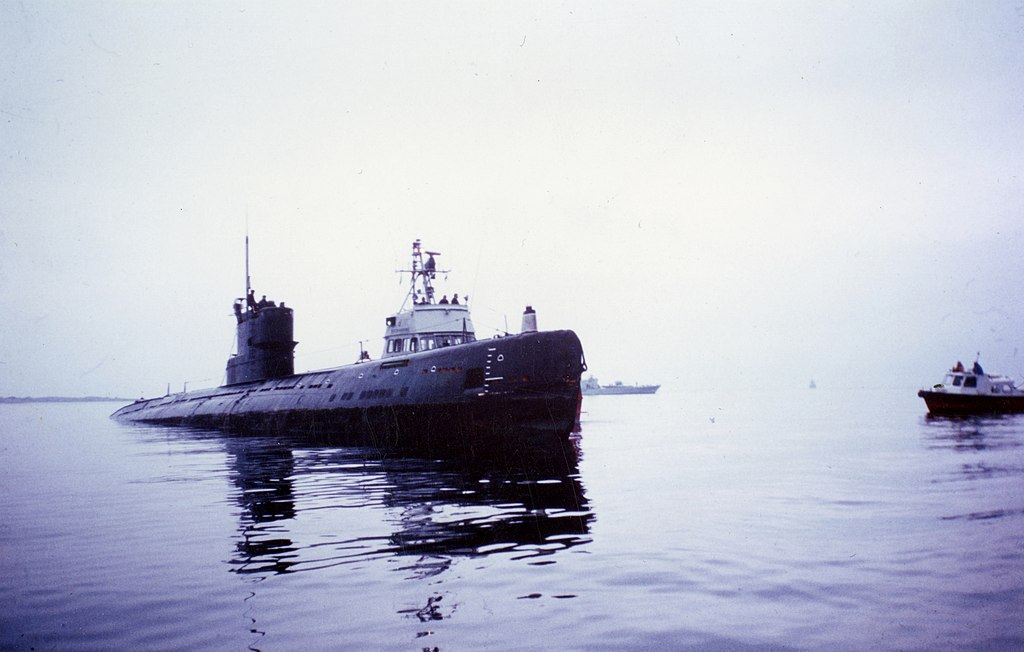
“Whiskey on the rocks” S363 in 1981
Since the early 1980s Sweden saw violations multiplied in its territorial waters by foreign (Soviet but also NATO submarines) and reports only camed to public consciousness on 27 October 1981, when a Whiskey-class ran aground in a restricted area of the well-patrolled and strategic Karlskrona archipelago, the derided western medias “Whiskey on the rocks.” The strong formal protest only met a soviet not plausible “unintentional navigational error”. But from there, as the cold war became “hotter again” at a level not seen since the Cuban missile crisis, the Swedish Navy became far more agressive in its searches and patrols, with some results.
At that stage however, the Project 613 had burn their conventional capabilities out, meeting far better models such as Germany’s type 209. They found, especialy in the baltic, a true replacement, the NATO Kilo class, which became a hit and were also well exported.
27 January 1961: S-80 is lost due to accidental flooding while submerged, the snorkel valve apparently did not work properly.
24 November 1972: Norwegian KNM Sklinna (Kobben class) had “contact” with a presumed Whiskey-class submarine after 14 days of “hunt” in Sognefjord as declassified in 2009
21 October 1981: S-178 run down by merchant vessel Refrizherator-13, Golden Horn Bay, Vladivostok.
27 October 1981: S-363 ran aground in Swedish waters, near Karlskrona naval base, the famous “whiskey on the rocks”
19 June 1984: a Whiskey-class is caught in a fishing-net, forced to surface in the Norwegian EEZ.
14 December 1989: Decommissioned Whiskey went loose while under tow to Nakskov, sank 2 miles west of Bornholm.
5 February 2007: Decommissioned S-194 flooeded and sank off Denmark while under tow to become a naval museum.
2009: Unidentified sunken Whiskey-class discovered in Sweden’s EEZ off Gotland, decommissioned which also sank while under tow.
Exports
Many of these were transferred to other countries after they filled their role and were replaced by more modern boats, most often of the Foxtrot type. 10 were transferred to Egypt, 12 to Indonesia (KRI Cakra (401), KRI Nanggala (407), KRI Nagabanda (403), KRI Trisula (402), KRI Nagarangsang (404), KRI Candrasa (408), KRI Alugoro (406), KRI Cundamani (411), KRI Hendrajala (405), KRI Pasopati (410), KRI Wijajadanu (409), KRI Bramastra (412)) but also four to North Korea, three to Syria, four to Poland, two to Bulgaria, one to Cuba and four ex-Soviet boats (with soviet crews) were left to Albania at Vlora base during the breakdown of Soviet-Albanian relations. They were maintained to stay active until the fall of USSR and dissolution of the warsaw pact.
 Albanians subs
Albanians subs
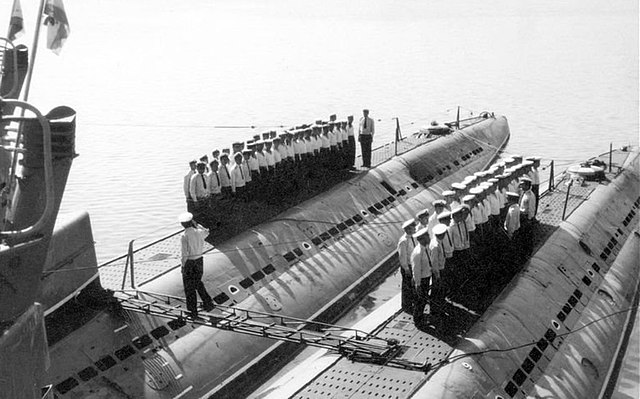
Albanian People’s Navy (four vessels, all retired) which were based at Porto Palermo
 Bulgarian subs
Bulgarian subs
Bulgarian Navy (two vessels, retired)
 Type 03 submarines
Type 03 submarines

In 1954, by government decision, working drawings and technical documentation were notably transferred to China as part of a broader technical agreement. The first three were entirely built in USSR, and transported in sections to China for assembly, from Shanghai, to the Jianan shipyard. They were tested in Lüshunkou (former Port Arthur) at the end of 1957. But there are contraduicting sources some claiming the boats were carried in empty sections, without equipment, just the cast bulkheads, metal sheets and the rest supplied in batches from metallurgical plants.
Subsequent submarines built in China were still dependent from Soviet steel, electrical equipment, machinery and weapons. At the end of 1957, after successful tests preparations started for a domestic production at the Wuhan Shipyard in Hankou. The lead submarine was tested in from November 1958 to January 1959. 15 were in construction and in total the Chinese 26 or less depending on sources were built as the Type 03 (presumably). Most sources however agrees on 21 boats, renamed 119-267 with Soviet components to built five more. They entered service 1957-64 and were stricken in 1989 (6) the other extant in the 1990s. China also received numerous WW2 boats before that, on series IV, one serie VI bis, four ShCh types, four serie XV or MV and four Series IX all in 1955.
However the bread and butter of Chinese Submarine forces became the Romeo class, built just after one was transferred, and the Soviet-Sino split.
 Egyptian 415 class (name unknown)
Egyptian 415 class (name unknown)
415, 418, 421, 432, 455, 477 (transferred 1957-58) to the Egyptian Navy (seven for other sources, all retired)
 Tjakra class
Tjakra class

Indonesian Navy (twelve vessels: KRI Tjakra, Nanggala, Nagabanda, Trisula, Nagarangsang, Tjandrasa, Alugoro, Tjundamani, Wijajadanu, Pasopati, Hendradjala, Bramastra, plus two as a source of spare parts, retired 1972-1990). Pasopati (410) was preserved as a monument.
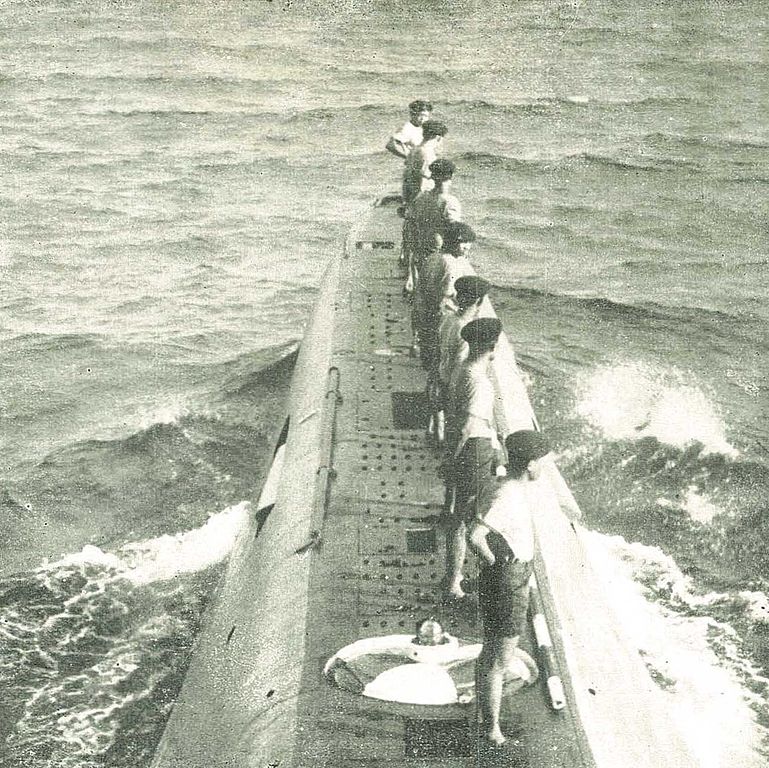
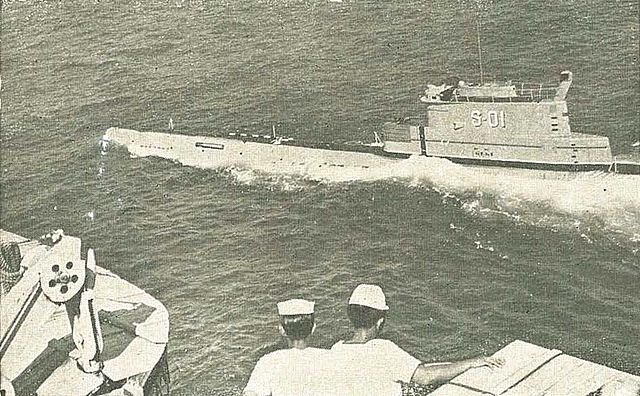
Kri Tjakra
 North Korean Boats (name unknown)
North Korean Boats (name unknown)
North Korean People’s Navy: (four vessels, inactive and likely retired). Transferred from USSR in 1955, Inactive in the 1990s. Contradictory reports says they were reported retired as of March 2011 whereas one was seemingly active in exercises by 2013. Most probably for training and kept as museum boat.
 Orzel class
Orzel class

“Orzel”, polish Whiskey class model
The Polish Navy saw the transfer of four vessels, which served from 1962 to 1986, all retired.
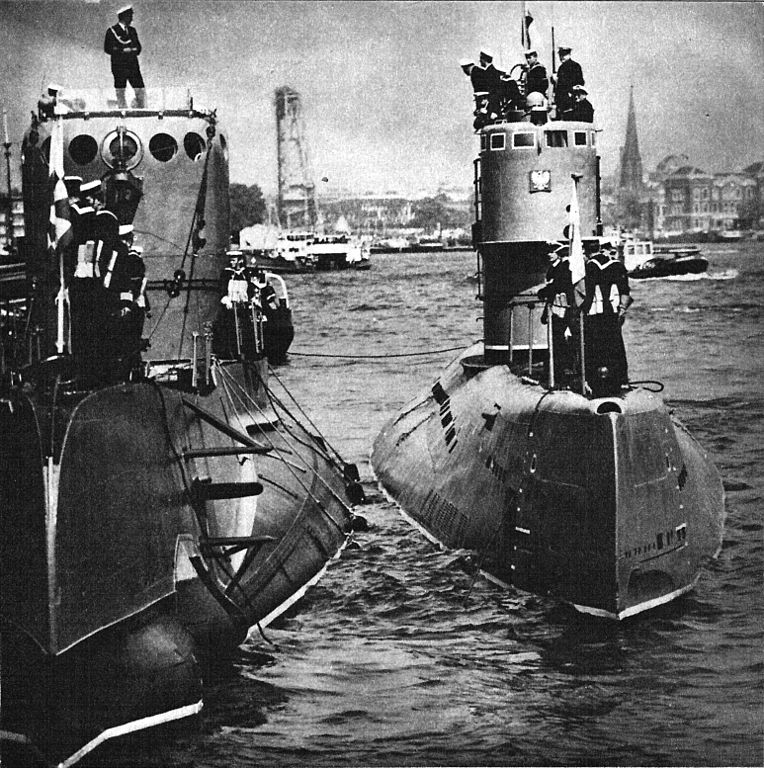
Polish ORP Sep and Bielik in Rostock in 1968
General Assessment
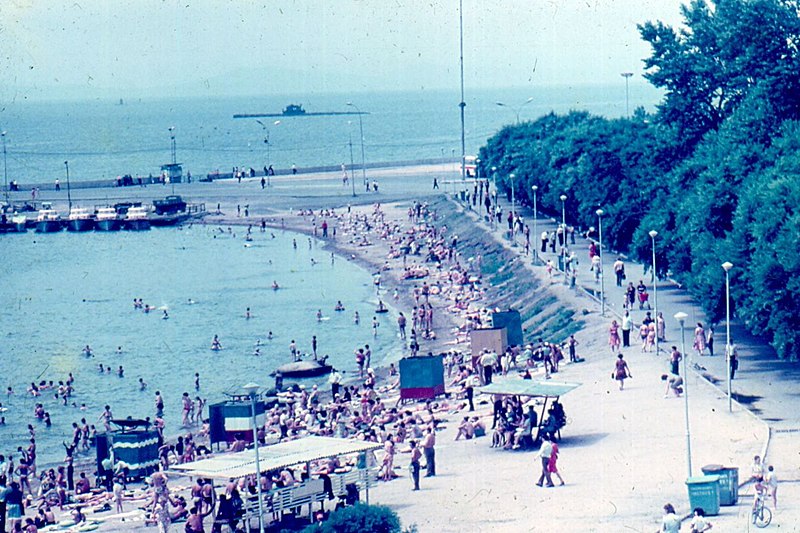
A Type 613 in the summer of 1982 off a beach at Vladisvostok.
Despite some issues, this fairly simple and reliable submarine was apparently beloved by Soviet submariners whe introduced. Notably its innovation and capabilities make it appealing compared to legacy WW2 boats. But despite all its simplicity, even primitive equipment in some case due to he rush into production, the Project 613 turned out to be one of the quietest submarines of the Soviet Navy, explaining in part its long active life. Some historians even compared to the famous Russian Mosin Nagant 1891 rifle. Also not outstanding, but reliable it also brought to Russia its first
export successes, being first widely sold abroad. Something repeated on later classes (see later).
In fact, their massive production will quickly exceed the capabilities of the Soviet navy to have them all crewed and serviced. The placement rate (submarines excluding reserves) was of only 87%. For only the units whose complete cycle is known to date, probably below ten, the type cycle was only 10.6 years for the first batches, 6.3 for the second and 9.65 for the last. S-74 was an exception, in service for 38.8 years, but S-365 was only serviced for 5.5 years while S-45, delivered on December 31, 1952, was in reserve as early as November 29, 1958 !
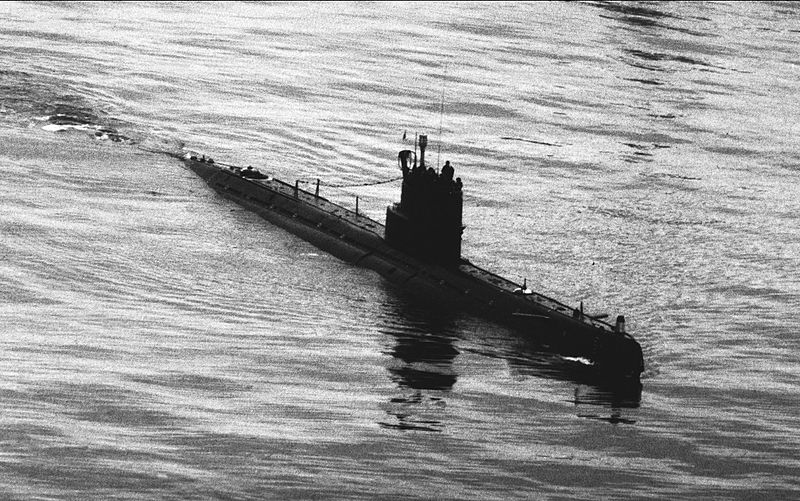
Initial missions were not dependent on new capabilities that much: Locate and destroy enemy warships and target merchant shipping second, while the 12 guided missile conversions made were to target warships only. Of couse these boats were an amazing improvements overe the earlier pre-war Type-S and Type-ShCh, being faster, quieter, deeper and having better sonar systems, but they had serious limitations, being very loud due to many many free-flood holes along the hull, a compromise in construction as they were considered “cheap” boats. The missile conversions were even louder due to the turbulences created by their large missile bins. But at least they gave the Soviets a well improved sea denial ability, paving the way for future designs.
Read More/Src
Books
Conway’s all the world’s fighting ships 1947-1995, “Soviet Union 1947–1991é” by Friedman, Norman (1995), NIP
Hampshire, Edward (2018). Soviet Cruise Missile Submarines of the Cold War. Osprey Publishing.
Pavlov, A. S. (1997). Warships of the USSR and Russia 1945–1995. NIP
Polmar, Norman & Moore, Kenneth J. (2004). Cold War Submarines: The Design and Construction of U.S. and Soviet Submarines. Potomac Books.
Polmar, Norman & Noot, Jurrien (1991). Submarines of the Russian and Soviet Navies, 1718–1990. NIP
Vilches Alarcón, Alejandro A. (2022). From Julietts to Yasens: Development and Operational History of Soviet Cruise-Missile Submarines. Europe@War (22). Helion & Co.
Weir, Gary E., and Boyle, Walter J. Rising Tide: The Untold Story of the Russian Submarines That Fought the Cold War Basic Books, 2003.
Links
submarines.narod.ru, excellent source on the type (RU)
wikipedia.org/ EN
On ru.wikipedia.org
on deepstorm.ru
on book.uraic.ru
on war-book.ru
on russianships.info
commons.wikimedia.org Submarine_Monument_Surabaya, interior visit
navweaps.com soviet torpedoes
on russianwarrior.com
soumarsov.eu fr
on topgun.rin.ru
on russianships.info
on forums.airbase.ru/
nice profile posters of all 613 types
Helion & Co, europe at war series From Julietts to Yasens: Development and Operational History of Soviet Nuclear-powered Cruise-Missile Submarines, 1958-2022
Videos
Model Kits
General query on scalemates
Long Bin 1:350, Pit road
On shapeways
3D
Note: First Published on Feb 2, 2017

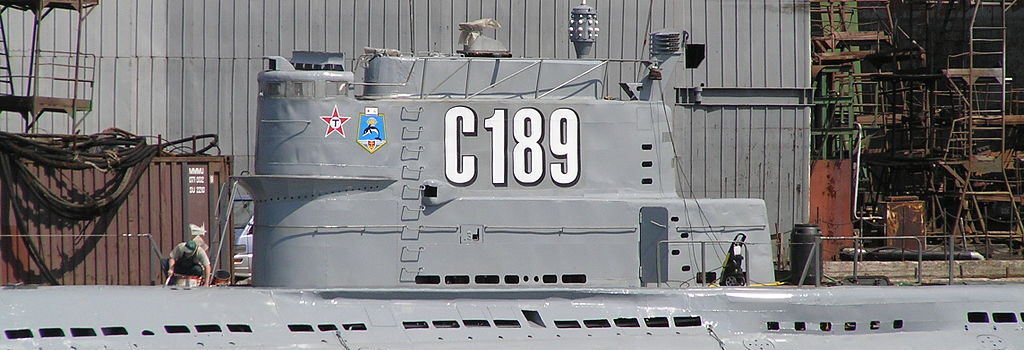



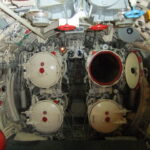
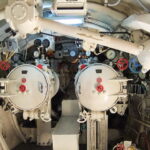
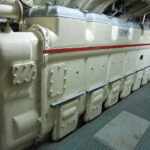
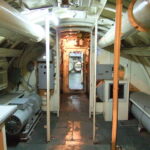
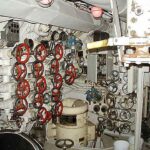
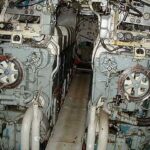
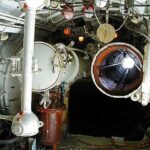
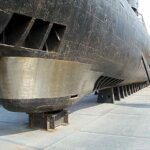
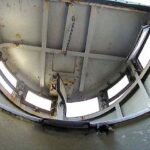
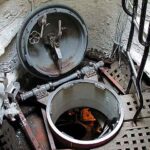
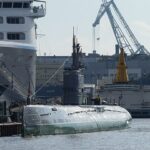
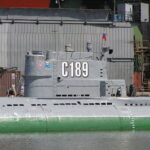
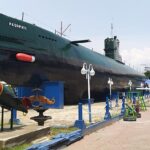
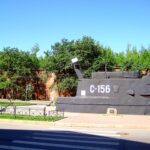
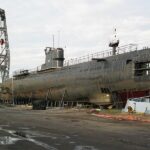

 Latest Facebook Entry -
Latest Facebook Entry -  X(Tweeter) Naval Encyclopedia's deck archive
X(Tweeter) Naval Encyclopedia's deck archive Instagram (@navalencyc)
Instagram (@navalencyc)





 French Navy
French Navy Royal Navy
Royal Navy Russian Navy
Russian Navy Armada Espanola
Armada Espanola Austrian Navy
Austrian Navy K.u.K. Kriegsmarine
K.u.K. Kriegsmarine Dansk Marine
Dansk Marine Nautiko Hellenon
Nautiko Hellenon Koninklije Marine 1870
Koninklije Marine 1870 Marinha do Brasil
Marinha do Brasil Osmanlı Donanması
Osmanlı Donanması Marina Do Peru
Marina Do Peru Marinha do Portugal
Marinha do Portugal Regia Marina 1870
Regia Marina 1870 Nihhon Kaigun 1870
Nihhon Kaigun 1870 Preußische Marine 1870
Preußische Marine 1870 Russkiy Flot 1870
Russkiy Flot 1870 Svenska marinen
Svenska marinen Søværnet
Søværnet Union Navy
Union Navy Confederate Navy
Confederate Navy Armada de Argentina
Armada de Argentina Imperial Chinese Navy
Imperial Chinese Navy Marinha do Portugal
Marinha do Portugal Mexico
Mexico Kaiserliche Marine
Kaiserliche Marine 1898 US Navy
1898 US Navy Sovietskiy Flot
Sovietskiy Flot Royal Canadian Navy
Royal Canadian Navy Royal Australian Navy
Royal Australian Navy RNZN Fleet
RNZN Fleet Chinese Navy 1937
Chinese Navy 1937 Kriegsmarine
Kriegsmarine Chilean Navy
Chilean Navy Danish Navy
Danish Navy Finnish Navy
Finnish Navy Hellenic Navy
Hellenic Navy Polish Navy
Polish Navy Romanian Navy
Romanian Navy Turkish Navy
Turkish Navy Royal Yugoslav Navy
Royal Yugoslav Navy Royal Thai Navy
Royal Thai Navy Minor Navies
Minor Navies Albania
Albania Austria
Austria Belgium
Belgium Columbia
Columbia Costa Rica
Costa Rica Cuba
Cuba Czechoslovakia
Czechoslovakia Dominican Republic
Dominican Republic Haiti
Haiti Hungary
Hungary Honduras
Honduras Estonia
Estonia Iceland
Iceland Eire
Eire Equador
Equador Iran
Iran Iraq
Iraq Latvia
Latvia Liberia
Liberia Lithuania
Lithuania Mandchukuo
Mandchukuo Morocco
Morocco Nicaragua
Nicaragua Persia
Persia San Salvador
San Salvador Sarawak
Sarawak Uruguay
Uruguay Venezuela
Venezuela Zanzibar
Zanzibar Warsaw Pact Navies
Warsaw Pact Navies Bulgaria
Bulgaria Hungary
Hungary

 Bundesmarine
Bundesmarine Dutch Navy
Dutch Navy Hellenic Navy
Hellenic Navy Marina Militare
Marina Militare Yugoslav Navy
Yugoslav Navy Chinese Navy
Chinese Navy Indian Navy
Indian Navy Indonesian Navy
Indonesian Navy JMSDF
JMSDF North Korean Navy
North Korean Navy Pakistani Navy
Pakistani Navy Philippines Navy
Philippines Navy ROKN
ROKN Rep. of Singapore Navy
Rep. of Singapore Navy Taiwanese Navy
Taiwanese Navy IDF Navy
IDF Navy Saudi Navy
Saudi Navy Royal New Zealand Navy
Royal New Zealand Navy Egyptian Navy
Egyptian Navy South African Navy
South African Navy






























 Ukrainian Navy
Ukrainian Navy dbodesign
dbodesign
I noticed that on tank encyclopedia they did articles on fake tanks
If you could write about the fictional red October that’d be pretty cool
Hi,
That’s not in the plans now, but feel free to submit an article !
Cheers, David B.
Dear Friend.
I have more pictures of the S189 that I took during my visit to that city on September of 2017. If you want them, please send me a mail to deliver them to you.
Greetings from Chile.
Hi Tomcat, yes sure, that would be nice !
Dave
Excellent page, very much good information, thank you!
Would you happen to know what sensor it is that can be found on top of the (lower) aft part of the conning tower on S-79/189?
Picture here: https://ibb.co/Jz6CcWm
Thanks!
Hi Oskar, it’s not original, likely a modern navigation radar to answer regulations. About the type, there are tons of models from Garmin, Simrad, etc.
Cheers,
David
Hi David,
Thanks, but could it be something else? I’m asking because there is one being sold at a auction by a guy who apparently at some point was working on scrapping a 613 from 1953 in Finland, and took all kinds of stuff with him home.
He sells it as a “sonar antenna”, and “the type of equipment that was supposed to be removed from the vessels before taking them to the scrapping yard, but someone probably had too much vodka and forgot about it.”.
I do not think it looks like a radar antenna and also the placing aft of the conning tower would be quite odd as it could not “see” forward if it was a navigational radar antenna.
The item weighs 23,5 kg, width ~40cm, height ~36cm, depth ~38cm. It is the same item as in the picture of S79/189, as the guy also has a picture of it where it it was installed, but the pictures are cluttered with copyright notices…
Picture of the cleaned up and polished item being sold here: https://ibb.co/dk7KCV0
BR, Oskar
Hi Oskar,
now i see your second photo, it can’t be a navigation radar indeed. I also saw the associated facebook page and third photo shows a frame around, so very unlilkely for a radar, the two appendages could be acousting sensors and thus, a Mars-24KIG noise direction finding station antenna or a modern modern noise direction finding sonar “Phoenix”. I’m not a soviet sonars specialist, more search would be necessary to nail it by analogy.
Cheers,
Hi David,
Thanks fo the info! I may have to buy it 🙂
Happy New Year!
BR, Oskar
Hi Oskar, i would’nt without certainty if i were you. Never saw it on any photo or plan…
Happy new year anyway ! 🙂
Hi David,
FYI, I found some additional info on the sensor on this site: https://forums.airbase.ru/2010/10/t63180_16–podvodnye-lodki-proekta-613-2.html
Translated from russian: “This is such a two-horned thing of a relatively small size; on the S-191 (and many Baltic ships) it was installed above the surface latrine. Used to determine the speed of sound in water.”
It can be seen also in several scenes in the “Whiskey on the rocks” -video.
BR, Oskar
It’s apparently the GISZ МГ-23 “Береста” / MG-23 “Beresta-M”, it can be found on various other subs also, with different installation locations, usually more hidden.
“On the submarines 667A, 667B, 667BD and 667BDR, a hydroacoustic station sensor for measuring the speed of sound was also installed on the starboard side of the bow superstructure”
“the MG-23 sensor (hydroacoustic station for measuring the speed of sound).. …This device was present on almost all boat projects, from the 633 project to modern nuclear ones, with slight fluctuations in shape.”
Hi Oskar,
Ok thanks for the info !
It might rarely usually be installed on this location, aft of the sail indeed.
Best,
David
the whiskey was in NO WAY more capable then the WW2 Typ VII Uboote. the capability is measured in accomplishments. thusly the VII were the most capable submarines ever built.
But what if you swap the Type VII for the Project 613 boats (or Type XXI) ?